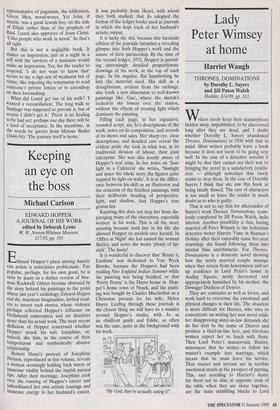Keeping an eye on the boss
Michael Carlson
EDWARD HOPPER: A JOURNAL OF HIS WORK edited by Deborah Lyons W. W. Norton/Whitney Museum, £17.95, pp. 105 Edward Hopper's place among Ameri- can artists is sometimes problematic. Too Popular, perhaps, for his own good, he is seen by many as a darker version of Nor- man Rockwell. Others become obsessed by the story behind his paintings to the point Where last year's anthology, Edward Hopper and the American Imagination, invited read- ers to invent such stories, whose violence Perhaps reflected Hopper's influence on Hollywood cameramen and art directors more than his actual work. The most recent deflation of Hopper concerned whether Hopper struck his wife Josephine, or, indeed, she him, in the course of their tempestuous and symbiotically abusive relationship. Robert Henri's portrait of Josephine Nivison, reproduced in this volume, reveals woman seemingly holding back waves of immense vitality behind the impish pursed lips. After their marriage, Josephine took over the running of Hopper's career and subordinated her own artistic leanings and Immense energy to her husband's career. It was probably from Henri, with whom they both studied, that Jo adopted the format of the ledger books used as journals in which she kept track of her husband's artistic output.
It is lucky she did, because this facsimile edition of the journals furnishes a revealing glimpse into both Hopper's work and the nature of their partnership. By the time of the second ledger, 1932, Hopper is provid- ing increasingly detailed proportionate drawings of his work, at the top of each page. In his angular, flat handwriting lie lists the material used. His skill as a draughtsman, evident from his etchings, also lends a new dimension to well-known paintings like 'Gas', where the sketch's etched-in sky lowers over the station, without the effects of evening light which dominate the painting.
Filling each page, in her expansive, rounded script, are Jo's descriptions of the work, notes on its composition, and records of its shows and sales. Her sharp eye, clear descriptions, and detailed care reveal the evident pride she took in what was, in its traditional division of labour, their joint enterprise. She was also keenly aware of Hopper's real aims. In her notes on 'Sun- light in a Cafeteria' she writes, 'Sunlight and space the whole story, the figures quite negated by light on walls'. It is in the differ- ence between his skill as an illustrator and the concerns of the finished paintings, with their deliberate bending of perspective, light, and shadow, that Hopper's true genius lies.
Knowing this does not stop her from dis- paraging many of the characters, especially women, in his work. This is all the more amusing because until late in his life she allowed Hopper no models save herself. In 'Office at Night' she has named the woman Shirley, and notes she wears 'plenty of lip- stick'. The hussy!
It is wonderful to discover that 'Route 6, Eastham' was dedicated to Van Wyck Brooks, because the Hoppers had been reading New England Indian Summer while the painting was being finished, or that 'Pretty Penny' is the Hayes house in Hop- per's home town of Nyack, and the paint- ing was bought by Charles MacArthur as a Christmas present for his wife, Helen Hayes. Leafing through these journals is the closest thing we will have to a wander around Hopper's studio, with Jo as an ebullient guide and Eddie, as often was the case, quiet in the background with his work.
My God, they're actually eating it!'


































































 Previous page
Previous page